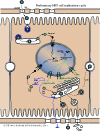The minichromosome
Structure of the minichromosome
Nuclear hepadnaviral cccDNA molecules are organized as a viral minichromosome. The histones H1, H2A, H2B, H3 and H4 are detected in the chromosome (Bock et al. 2001) Rating=2. HBV core protein (HBc) is a component of the HBV minichromosome with a strong binding affinity to HBV double-stranded DNA. Association of HBc with the cccDNA results in a reduction of the nucleosomal spacing of the HBV nucleoprotein complexes by approximately 10 % compared to the cellular chromatin. HBx is also recruited to the minichromosome as well as cellular histone acetyltransferases CBP, p300, and PCAF/GCN5, and the histone deacetylases HDAC1 and hSirt1 (Belloni et al. 2009) Rating=1. In DHBV, two populations of hepadnaviral cccDNA minichromosomes have been identified, with a 50/50 ratio corresponding to a full or half complement of nucleosomes, probably reflecting changes in transcriptional regulation between the two populations (Newbold et al. 1995) Rating=1.
Intracellular regulation of the minichromosome
The cccDNA content in liver cells in natural infections has been reported to be low (between 5 and 50 copies per cell), and is very important for establishing and maintaining HBV replication (Wong et al. 2004) Rating=2.("Dandri et al. 2000":http://www.ncbi.nlm.nih.gov/pubmed/10869302) Rating=2.
The generation of cccDNA seems to be regulated in a virus specific manner, since the conversion of rcDNA to cccDNA of DHBV is more efficient than HBV in the same human background (Kock et al. 2010) Rating=2. Primary duck hepatocytes infected with a mutant of envelope protein show higher cccDNA levels than wild-type virus (Summers et al. 1990) Rating=1, showing the important link between the envelope protein and the cccDNA amplification. Similar results in HBV show that absence of envelope proteins leads to a more than 6 fold increase in the level of cccDNA (Lentz et al.2011) Rating=2.


